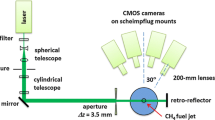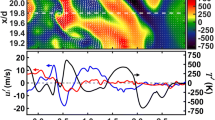Abstract
High-speed tomographic particle image velocimetry (TPIV) is demonstrated in turbulent reactive flows at acquisition rates ranging from 10 to 16 kHz. The 10-kHz TPIV measurements are combined with planar laser-induced fluorescence (PLIF) imaging of OH to mark the high-temperature reaction zone of the flame. Simultaneous TPIV/OH PLIF measurements are applied to the stabilization region of a weakly turbulent lifted dimethyl ether (DME)/air jet flame (Re D = 7,600) and the mixing layer of a turbulent partially premixed DME/air jet flame (Re D = 29,300). In the lifted jet flame, vortical structures exhibit time-dependent morphological changes and eventually dissipate as they approach the flame. In the near field of the turbulent jet flame, dynamics of localized extinction are captured as coherent structures with high compressive strain rates interact with the reaction zone and subsequently break apart. The principal axis of compressive strain has a strong preferential orientation at 45° with respect to the jet axis. The three-dimensional velocity field measurements are used to evaluate biases in two-dimensional (2D) measurements of compressive strain rates in a turbulent jet flame. The biases in the 2D measurements primarily stem from out-of-plane orientation of the principal axis of compressive strain. Comparisons with a constant density turbulent non-reactive jet (Re D = 22,600) show that the jet flame has larger coherent structures that are confined near the reaction zone. Data from the non-reactive jet are also used to evaluate effects of noise, bias, and spatial averaging on measurements of the velocity and velocity gradients.
















Similar content being viewed by others
References
Adrian RJ (1991) Particle-imaging techniques for experimental fluid mechanics. Annu Rev Fluid Mech 23:261–304
Atkinson C, Coudert S, Foucaut JM, Stanislas M, Soria J (2011) The accuracy of tomographic particle image velocimetry for measurements of a turbulent boundary layer. Exp Fluids 50:1031–1056
Baum E, Peterson B, Surmann C, Michaelis D, Böhm B, Dreizler A (2013) Investigation of the 3D flow field in an IC engine using tomographic PIV. Proc Combust Inst 34:2903–2910
Coriton, B, Frank, JH, Gomez A (2013) Effects of strain rate, turbulence, reactant stoichiometry and heat losses on the interaction of turbulent premixed flames with stoichiometric counterflowing combustion products. Combust Flame 160:2442–2456
Donbar JM, Driscoll JF, Carter CD (2001) Strain rates measured along the wrinkled flame contour within turbulent non-premxied jet flames. Combust Flame 125:1239–1257
Egolfopoulos FN (1994) Dynamics and structure of unsteady, strained, laminar premixed flames. Proc Combust Inst 25:1365–1373
Elsinga GE, Wieneke B, Scarano F, van Oudheusden BW (2006) Tomographic particle image velocimetry. Exp Fluids 41:933–947
Elsinga GE, Wieneke B, Scarano F, Schröder A (2008) Tomographic 3D-PIV and applications. In: Schroeder A, Willert CE (eds) Particle image velocimetry, vol 112. Topics Applied Physics, pp 103–125
Elsinga GE, Westerweel J, Scarano F, Novara M (2011) On the velocity of ghost particles and the bias errors in tomographic PIV. Exp Fluids 50:825–838
Filatyev SA, Driscoll JF, Carter CD, Donbar JM (2005) Measured properties of turbulent premixed flames for model assessment, including burning velocities, stretch rates and surface densities. Combust Flame 141:1–21
Foucaut JM, Stanislas M (2002) Some considerations on the accuracy and frequency response of some derivative filters applied to particle image velocimetry vector fields. Meas Sci Technol 13:1058–1071
Foucaut JM, Carlier J, Stanislas M (2004) PIV optimization for the study of turbulent flow using spectral analysis. Meas Sci Technol 15:1046–1058
Frank JH, Kaiser SA (2010) High-resolution imaging of turbulence structures in jet flames and non-reacting jets with laser Rayleigh scattering. Exp Fluids 49:823–837
Frank JH, Kalt PAM, Bilger RW (1999) Measurements of conditional velocities in turbulent premixed flames by simultaneous OH PLIF and PIV. Combust Flame 116:220–232
Frank JH, Kaiser SA, Long MB (2002) Reaction-rate, mixture-fraction, and temperature imaging in turbulent methane/air jet flames. Proc Combust Inst 29:2687–2694
Gamba M, Clemens NT, Ezekoye OA (2013) Volumetric PIV and 2D OH PLIF imaging in the far-field of a low Reynolds number nonpremixed jet flame. Meas Sci Technol 24:024001
Ganapathisubramani B, Lakshminarasimhan K, Clemens NT (2007) Determination of complete velocity gradient tensor by using cinematographic stereoscopic PIV in a turbulent jet. Exp Fluids 42:923–939
Ganapathisubramani B, Lakshminarasimhan K, Clemens NT (2008) Investigation of three-dimensional structure of fine scales in a turbulent jet by using cinematographic stereoscopic particle image velocimetry. J Fluid Mech 598:141–175
Garcia D (2010) Robust smoothing of gridded data in one and higher dimensions with missing values. Comput Stat Data Anal 54:1167–1178
Garcia D (2011) A fast all-in-one method for automated post-processing of PIV data. Exp Fluids 50:1247–1259
Gomez A, Rosner DE (1993) Thermophoretic effects on particles in counterflow laminar diffusion flames. Combust Sci Technol 89:335–362
Han D, Mungal MG (2003) Simultaneous measurements of velocity and CH distributions. Part 1: jet flames in co-flow. Combust Flame 132:565–590
Hearst RJ, Buxton ORH, Ganapathisubramani B, Lavoie P (2012) Experimental estimation of fluctuating velocity and scalar gradients in turbulence. Exp Fluids 53:925–942
Kaiser SA, Frank JH (2009) Spatial scales of extinction and dissipation in the near field of non-premixed turbulent jet flames. Proc Combust Inst 32:1639–1646
Kaiser SA, Frank JH, Long MB (2005) Use of Rayleigh imaging and ray tracing to correct for beam-steering effects in turbulent flames. Appl Opt 44:6557–6564
Keane RD, Adrian RJ (1990) Optimization of particle image velocimetry. Part I: Double pulsed systems. Meas Sci Technol 1:1202–1215
Kee RJ, Rupley FM, Miller JA, Coltrin ME, Grcar JF, Meeks E, Moffat HK, Lutz AE, Dixon-Lewis G, Smooke MD, Warnatz J, Evans GH, Larson RS, Mitchell RE, Petzold LR, Reynolds WC, Caracotsios M, Stewart WE, Glarborg P, Wan C, McLellan CL, Adigun O, Houf WG, Chou CP, Miller SF, Ho P, Young PD, Young DJ, Hodgson DW, Petrova MV, Puduppakkam KV (2007) CHEMKIN Collection, release 4.1.1. Reaction Design, Inc., San Diego, CA
Kim M, Yoon Y (2007) Flame residence time and strain rate in turbulent hydrogen non-premixed jet flames with coaxial air. Proc Combust Inst 31:1609–1616
Kothnur PS, Tsurikov MS, Clemens NT, Donbar JM, Carter CD (2002) Planar imaging of CH, OH and velocity in turbulent non-premixed jet flames. Proc Combust Inst 29:1921–1927
Lavoie P, Avallone G, De Gregorio F, Romano GP, Antonia RA (2007) Spatial resolution of PIV for the measurement of turbulence. Exp Fluids 43:39–51
Mullin JA, Dham WJA (2006) Dual-plane stereo particle image velocimetry measurements of velocity gradient tensor fields in turbulent shear flow. I. Accuracy assessments. Phys Fluids 18:035101
Prasad AK, Adrian RJ (1993) Stereoscopic particle image velocimetry applied to liquid flows. Exp Fluids 15:49–60
Rehm JE, Clemens NT (1998) The relationship between vorticity/strain and reaction zone structure in turbulent non-premixed jet flames. Proc Combust Inst 27:1113–1120
Rhem JE, Clemens NT (1999) The association of scalar dissipation rate layers and OH zones with strain, vorticity, and 2-D dilation fields in turbulent nonpremixed jets and jet flames. AIAA-99-0676, 37th Aerospace Sciences Meeting
Scarano F (2003) Theory of non-isotropic spatial resolution in PIV. Exp Fluids 35:268–277
Scarano F (2013) Tomographic PIV: principles and practice. Meas Sci Technol 24:012001
Scarano F, Poelma C (2009) Three-dimensional vorticity patterns of cylinder wakes. Exp Fluids 47:69–83
Sick V (2013) High speed imaging in fundamental and applied combustion research. Proc Combust Inst 34:3509–3530
Steinberg AM, Driscoll JF, Ceccio SL (2009) Three-dimensional temporally resolved measurements of turbulence-flame interactions using orthogonal-plane cinema-stereoscopic PIV. Exp Fluids 47:527–547
Steinberg AM, Boxx I, Arndt CM, Frank JH, Meier W (2011) Experimental study of flame-hole reignition mechanism in a turbulent non-premixed jet flame using sustained multi-kHz PIV and crossed-plane OH PLIF. Proc Combust Inst 33:1663–1672
Tsurikov MS, Clemens NT (2002) The structure of dissipative scales in axisymmetric turbulent gas-phase jets. AIAA 2002-0164
Wang G, Karpetis AN, Barlow RS (2007) Dissipation length scales in turbulent nonpremixed jet flames. Combust Flames 148:62–75
Weinkauff J, Michaelis D, Dreizler A, Böhm B (2013) Tomographic PIV measurements in a turbulent lifted jet flame. Exp Fluids 54:1624
Westerweel J (2008) On velocity gradients in PIV interrogation. Exp Fluids 44:831–842
Westerweel J, Scarano F (2005) Universal outlier detection for PIV data. Exp Fluids 39:1096–1100
Wieneke B (2008) Volume self-calibration for 3D particle image velocimetry. Exp Fluids 45:549–556
Worth NA, Nickels TB, Swaminathan N (2010) A tomographic PIV resolution study based on homogeneous isotropic turbulence DNS data. Exp Fluids 49:637–656
TNF Workshop, http://www.ca.sandia.gov/TNF, Barlow, RS, Eds., Sandia National Laboratories
Zhang J, Tao B, Katz J (1997) Turbulent flow measurement in a square duct with hybrid holographic PIV. Exp Fluids 23:373–381
Zhao Z, Chaos M, Kazakov A, Dryer FL (2008) Thermal decomposition reaction and a comprehensive kinetic model of dimethyl ether. Int J Chem Kinet 40:1–18
Acknowledgments
The authors thank Mr. Erxiong Huang for his expert assistance in the laboratory. The authors gratefully acknowledge the support of the US Department of Energy, Office of Basic Energy Sciences, Division of Chemical Sciences, Geosciences, and Biosciences. Sandia National Laboratories is a multiprogram laboratory operated by Sandia Corporation, a Lockheed Martin Company, for the US Department of Energy under contract DE-AC04-94-AL85000. A. Steinberg acknowledges the support of the US Air Force Office of Scientific Research under Grant No. FA9550-13-1-0070, Project Monitor Dr. Chiping Li.
Author information
Authors and Affiliations
Corresponding author
Electronic supplementary material
Below is the link to the electronic supplementary material.
Online Resource 1: Simultaneous 10-kHz TPIV and OH PLIF measurements obtained in the stabilization region of a lifted jet flame. Blue isosurfaces correpspond to an enstrophy of ω 2 = 15 × 106 s−2. Velocity vectors are represented in the same plane as the OH PLIF images (1 out of 16 in-plane vectors displayed). (MPG 5020 kb)
348_2014_1743_MOESM2_ESM.mpg
Online Resource 2: Simultaneous 10-kHz TPIV and OH PLIF measurements in the turbulent partially premixed DME/air jet flame of Fig. 2b at y/D = 20. Blue isosurfaces correspond to a principal compressive strain rate of Г o = −15 × 103 s−1. Velocity vectors are represented in the same plane as the OH PLIF images (1 out of 16 in-plane vectors displayed). (MPG 6270 kb)
Rights and permissions
About this article
Cite this article
Coriton, B., Steinberg, A.M. & Frank, J.H. High-speed tomographic PIV and OH PLIF measurements in turbulent reactive flows. Exp Fluids 55, 1743 (2014). https://doi.org/10.1007/s00348-014-1743-3
Received:
Revised:
Accepted:
Published:
DOI: https://doi.org/10.1007/s00348-014-1743-3




